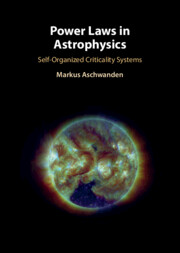Refine listing
Actions for selected content:
17002 results
12 - Magnetospheric Phenomena
- from Part II - Astrophysical SOC Phenomena
-
- Book:
- Power Laws in Astrophysics
- Published online:
- 05 December 2024
- Print publication:
- 12 December 2024, pp 147-158
-
- Chapter
- Export citation
7 - Solar Photospheric Events
- from Part II - Astrophysical SOC Phenomena
-
- Book:
- Power Laws in Astrophysics
- Published online:
- 05 December 2024
- Print publication:
- 12 December 2024, pp 106-119
-
- Chapter
- Export citation
3 - Waiting Time Distributions
- from Part I - Fundamentals of SOC
-
- Book:
- Power Laws in Astrophysics
- Published online:
- 05 December 2024
- Print publication:
- 12 December 2024, pp 44-58
-
- Chapter
- Export citation
2 - Power Law Size Distributions
- from Part I - Fundamentals of SOC
-
- Book:
- Power Laws in Astrophysics
- Published online:
- 05 December 2024
- Print publication:
- 12 December 2024, pp 25-43
-
- Chapter
- Export citation
14 - Stellar Systems
- from Part II - Astrophysical SOC Phenomena
-
- Book:
- Power Laws in Astrophysics
- Published online:
- 05 December 2024
- Print publication:
- 12 December 2024, pp 168-183
-
- Chapter
- Export citation
Contents
-
- Book:
- Power Laws in Astrophysics
- Published online:
- 05 December 2024
- Print publication:
- 12 December 2024, pp vii-xii
-
- Chapter
- Export citation
Foreword
-
- Book:
- Power Laws in Astrophysics
- Published online:
- 05 December 2024
- Print publication:
- 12 December 2024, pp xiii-xvi
-
- Chapter
- Export citation
8 - Solar Radio Bursts
- from Part II - Astrophysical SOC Phenomena
-
- Book:
- Power Laws in Astrophysics
- Published online:
- 05 December 2024
- Print publication:
- 12 December 2024, pp 120-125
-
- Chapter
- Export citation
11 - Solar Wind
- from Part II - Astrophysical SOC Phenomena
-
- Book:
- Power Laws in Astrophysics
- Published online:
- 05 December 2024
- Print publication:
- 12 December 2024, pp 139-146
-
- Chapter
- Export citation
Part I - Fundamentals of SOC
-
- Book:
- Power Laws in Astrophysics
- Published online:
- 05 December 2024
- Print publication:
- 12 December 2024, pp 1-2
-
- Chapter
- Export citation
10 - Solar Energetic Particle Events
- from Part II - Astrophysical SOC Phenomena
-
- Book:
- Power Laws in Astrophysics
- Published online:
- 05 December 2024
- Print publication:
- 12 December 2024, pp 133-138
-
- Chapter
- Export citation
5 - Solar Flare Soft X-Rays
- from Part II - Astrophysical SOC Phenomena
-
- Book:
- Power Laws in Astrophysics
- Published online:
- 05 December 2024
- Print publication:
- 12 December 2024, pp 72-88
-
- Chapter
- Export citation

Power Laws in Astrophysics
- Self-Organized Criticality Systems
-
- Published online:
- 05 December 2024
- Print publication:
- 12 December 2024
4 - 2pN Gravitoelectric Effects: Mass Monopoles
-
- Book:
- General Post-Newtonian Orbital Effects
- Published online:
- 28 November 2024
- Print publication:
- 05 December 2024, pp 73-83
-
- Chapter
- Export citation
15 - The Future of Humankind
- from Part VI - Futures
-
- Book:
- From Stars to Life
- Published online:
- 22 November 2024
- Print publication:
- 05 December 2024, pp 341-352
-
- Chapter
- Export citation
Appendix D - Spin-Orbit Orientation and Lorentz-Violating Coefficients
-
- Book:
- General Post-Newtonian Orbital Effects
- Published online:
- 28 November 2024
- Print publication:
- 05 December 2024, pp 194-196
-
- Chapter
- Export citation
9 - Mars
- from Part IV - Astrobiological Targets
-
- Book:
- From Stars to Life
- Published online:
- 22 November 2024
- Print publication:
- 05 December 2024, pp 203-221
-
- Chapter
- Export citation
10 - Icy Worlds
- from Part IV - Astrobiological Targets
-
- Book:
- From Stars to Life
- Published online:
- 22 November 2024
- Print publication:
- 05 December 2024, pp 222-245
-
- Chapter
- Export citation
Appendix I - Coefficients of the Power-Law Mass Density Profile Orbital Precessions
-
- Book:
- General Post-Newtonian Orbital Effects
- Published online:
- 28 November 2024
- Print publication:
- 05 December 2024, pp 212-213
-
- Chapter
- Export citation
Preface
-
- Book:
- From Stars to Life
- Published online:
- 22 November 2024
- Print publication:
- 05 December 2024, pp xi-xiv
-
- Chapter
- Export citation
